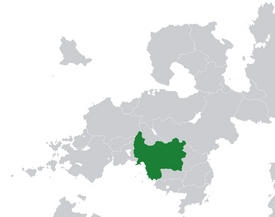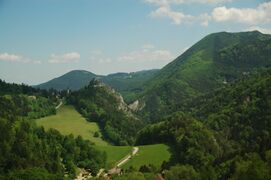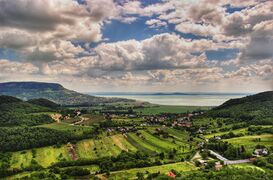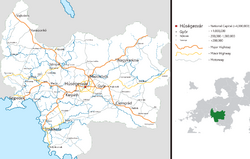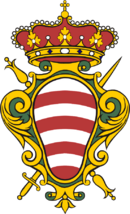Granzery
This article is incomplete because it is pending further input from participants, or it is a work-in-progress by one author. Please comment on this article's talk page to share your input, comments and questions. Note: To contribute to this article, you may need to seek help from the author(s) of this page. |
Granzerian Kingdom Grozyar Királyság (Granzerian Language) | |
|---|---|
Location of Granzery (dark green) | |
| Capital and largest city | Hűségesvár |
| Official languages | Granzerian |
| Recognised national languages | Pererran Zastrian |
| Ethnic groups (2013) | 83.1% Granzerian 5.5% Pererran 1.5% Zastrian 4.1% Other Patyrian 3.8% Other |
| Demonym(s) | Granzerian official |
| Government | Federal parliamentary constitutional monarchy |
• King | Karoly III |
| István Árpád | |
| Legislature | Senate |
| Area | |
• Total | 427,680 km2 (165,130 sq mi) |
• Water (%) | 1.10% |
| Population | |
• 2020 estimate | 61,556,304 |
• Density | 143.9/km2 (372.7/sq mi) |
| GDP (nominal) | 2020 estimate |
• Total | $1.976 trillion |
• Per capita | $32,105 |
| HDI (2020) | very high |
| Currency | Granzerian Korona (₭) |
| Date format | dd/mm/yyyy (AD) |
| Driving side | right |
| Calling code | +17 |
| ISO 3166 code | GRZ |
| Internet TLD | .grz |
Granzery, officially the Granzerian Kingdom (Granzerian: Grozyar Királyság), is a Constitutional Monarchy located in southern Patyria. It is ruled by the Senate of the Granzerian Kingdom, for which an election is held every 3 years, and the Prime Minister of Granzery, for which elections are held at the same time as the Senate. Granzery is comprised of nine regions, the largest of which Karpatia, is home to the Second largest city in the nation, Csongrád. Győr-Hűségesvár is the smallest by land area but second largest by population, and is home to the capital city of Hűségesvár.
The land that comprises modern Granzery has been inhabited by a variety of different ethnic groups, including TBA. The modern Granzerian people were originally nomadic tribes from central Oridia and the modern day Aitic Federation, who migrated to the Granzerian Basin around the mid 8th Century CE. The modern Granzerian State was established in the late 8th Century by the Granzerian vezér Zoltán, finally settling the Grozyar people permanently in the Granzerian basin and converting to Catholicism in 923. Granzery had become a regional power in south-eastern Patyria by the mid 11th Century, reaching its cultural peak during the Middle Ages and early Renaissance period.
In the early 20th Century Granzery experienced significant financial and political issues, eventually culminating in the 1925 Granzerian Revolution, and the installation of a single-party communist Dictatorship. During the Great War, Granzery was a member of the Coalition, and fought extensively on the Zacotian and Vierz fronts. Following the war Granzery was split between the monarchist North Granzery and democratic South Granzery, for 41 years before the Granzerian Compromise, and re-unification of Granzery.
Granzery is made up primarily of Granzerian people, who constitute 83.1% of the population, the remainder consisting of minority groups, the majority of these being Pererrans and Zastrians. Granzery is a high-income Patyrian country, and ranks TBA on the Human Development Index. Granzery's rich cultural history includes significant contributions to the arts, music, literature, sports, science and technology. It is one of the most popular tourist destinations in Patyria and is home to the largest lake in Central Patyria, and is famed for it's skiing and natural landscapes.
Etymology
The name Granzery originates from the Vierz word Grenze, which was used by the ethnic Vierz kingdoms inhabiting the Granzerian region prior to the Grozyar migrations of 700AD. It was used to describe Grozyar tribes as "those beyond the borders". The term Grozyarország is used natively, although it is sometimes shortened to Grozyar.
History
Prehistory
Antiquity
Grozyar Migrations
Medieval Granzery
Granzerian Renaissance
Communist Granzery
Great War
Divided Granzery
The Granzerian Compromise
Modern Day
Geography
The vast majority of Granzery's citizens live within either the Granzerian Basin regions of Győr-Hűségesvár and Bastarny, or the coastal regions of Vadász Völgy and Mocsárföld, both are temperate in climate with a diverse quantity of natural wildlife including bears, beavers, deer and others. The mountainous regions of Transkarpatia and Nagykert are dominated by the Karpaty Mountains and Zemplén Mountains, the latter of which is home to the highest peak in Granzery, Mount Szabar. Felső-Válicka and Jász-Nagykun are the two westernmost provinces of Granzery, and are some of the poorest regions in Granzery.
Hills in the Region of Bastarny.
Farms in northern Vadász Völgy.
Mount Szabar, Highest point in Granzery at 3,376m.
Politics
Granzery is a federal parliamentary constitutional monarchy. The Granzerian political system operates under a framework laid out in 1986 following the Granzerian compromise and the unification of Granzery. As a constitutional monarchy, King Karoly III reigns as the King of Granzery, while the elected legislature acts as the government, thus, in practice the King of Granzery has no legal legislative or executive powers. The government is separated into three levels, local, regional and federal government, elections for local and regional governments occur every four years, while elections for the federal government are held every three years in a single-round first-past-the-post election. The Granzerian parliament is bicameral with the upper house (the Senate) and lower house (Federal Assembly).
The federal government is separated into three branches:
- Legislature: the bicameral Parliament, defined in the 1986 constitution as comprising the monarch, the Senate, and the Federal Cabinet;
- Executive: the Federal Executive Cabinet, which in practice gives legal effect to the decisions of the parliament, comprising the prime minister and ministers of state who advise the monarch
- Judiciary: the National Court of Granzery and other federal courts, whose judges are appointed by the monarch on advice of the Federal Executive Cabinet.
The 50 seats of the Senate are elected on a regional level, with 5 Senators elected per region, with the exception of Győr-Hűségesvár, which contributes 10 Senators. The Federal Assembly has 674 members from electoral divisions known as "Választókerekek" (Electoral Seats). Elections for both chambers are normally held every three years simultaneously, during a general election.
The Prime Minister (miniszterelnök) is elected by the Federal Assembly, serving as the head of government and exercising executive power. Traditionally, the Prime Minister is the leader of the largest party in parliament. The Prime Minister selects Cabinet ministers and has the exclusive right to dismiss them, although cabinet nominees must appear before consultative open hearings before one or more parliamentary committees, survive a vote in the Federal Assembly, and be formally approved by the monarch. The cabinet reports to parliament.
Political Parties
Since the unification of Granzery, Granzery has a Multi-party system. The last general election was held on the 31st of October, 2018. The result was a minority government led by the Liberal Democratic Party, with the support of one independent and the Dialogue for Granzery party.
Foreign Relations
Since the unification of Granzery, it has remained a largely neutral power internationally, but retains a position as an observer state of not!NATO and is a founding member of the Leisau Group. Since unification, relations with Granzery's northern neighbours have been rocky, particularly with Vierzland and Lairea, while relations with Vonzumier and Tierada have slowly deteriorated over time, causing the Granzerian state to align more closely with the Alaavus Summit, and principally the Aitic Federation.
Administrative Divisions
Military
Granzery's armed forces are the Royal Defence Force, which is comprised of the Granzerian Navy, Granzerian Ground Forces and Granzerian Air Force. The King holds the titular role of Commander-in-Chief, and appoints a Chief of the Royal Defence Force from one of the armed services on the advice of the government. Day-to-day force operations are under the command of the Chief, while broader administration and the formulation of defence policy is undertaken by the Minister and Department of Defence. Military service is voluntary, with an annual defence spending in 2018 of 2.6% of GDP, and is the worlds TBA largest defence budget.
Sciences
Economy
Demographics
Ethnic groups
Religious Groups
Major cities
Largest cities or towns in Granzery
2016 Census | |||||||||
|---|---|---|---|---|---|---|---|---|---|
| Rank | Region | Pop. | Rank | Region | Pop. | ||||
 Hűségesvár  Csongrád |
1 | Hűségesvár | Győr-Hűségesvár | 4,801,147 | 11 | Vajkváros | Jász-Nagykun | 613,984 |  Sejpedek 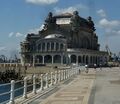 Vizifekete |
| 2 | Csongrád | Bastarny | 2,889,112 | 12 | Sztrojek | Karpátia | 546,390 | ||
| 3 | Sejpedek | Vadász Völgy | 2,319,682 | 13 | Folyókoznak | Mocsárföld | 533,284 | ||
| 4 | Vizifekete | Mocsárföld | 1,755,016 | 14 | Cserogy | Eniglia | 484,670 | ||
| 5 | Mezővörös | Győr-Hűségesvár | 1,673,320 | 15 | Társföld | Vadász Völgy | 476,654 | ||
| 6 | Karpáth | Karpátia | 1,513,554 | 16 | Palánk | Bastarny | 430,317 | ||
| 7 | Győr | Győr-Hűségesvár | 1,420,703 | 17 | Etelköz | Mocsárföld | 338,567 | ||
| 8 | Nagykanizsa | Nagykert | 1,378,239 | 18 | Zombor | Bastarny | 299,478 | ||
| 9 | Karácsonkő | Jász-Nagykun | 1,129,812 | 19 | Újvidék | Felső-Válicka | 236,100 | ||
| 10 | Pecsi | Eniglia | 804,213 | 20 | Réjkövek | Bastarny | 212,094 | ||
Health
The Granzerian health care system is considered a "mixed" health care system, with a universal health care system largely financed by government health insurance, however despite this, citizens can elect to pay for private health insurance and health care. The State Medical Insurance scheme or ÁEB (Granzerian: "állami egészségügyi biztosítás") is completely free for children, handicapped people and pensioners. The highest cause of death in Granzery is Cardiovascular disease, causing 47.5% of all total deaths annually, the second highest cause of death is cancer with 26.7% of all annual deaths attributed to it. Life Expectancy in Granzery in 2019 was 78.5 years for males and 83.4 years for females. The leading preventable cause of death in Granzery is Cigarette smoking, responsible for 8.1% of total mortality and disease. Ranked second in preventable causes is Hypertension at 7.3%, with Obesity third at 6.1%.
There are huge differences between the western and eastern parts of Granzery, heart disease, hypertension, stroke, and suicide is prevalent in the mostly agricultural and low-income regions of Karpatia, Mocsárföld and Jász-Nagykun, but infrequent in the high-income and middle class characteristic Győr-Hűségesvár and Nagykert. The homicide rate was 1.3 per 100,000 people at the end of 2018.
Education
Primary and Secondary education in Granzery is predominantly public, run by the Education Cabinet (Granzerian: "Oktatási kormány") Primary education usually lasts for eight years, from the ages of 4 to 12, and is exclusively publically funded and run. Secondary education includes three traditional types of schools focused on different academic levels. The "Akadémia" or Academy system lasts between 4 and 6 years, and generally prepares the most gifted students for university education, and is the most common enrolment in Granzery, including approximately 62% of total enrolments. The "Főiskola" or Vocational College System prepares students for tertiary vocational education and lasts for four years. "Iskola szakember" or Specialised School system lasts between 4 and 8 years and educates students in various specialised ways such as sporting, music and drama. The system is partly flexible and bridges exist, graduates from an Academic school can achieve a two years program to have access to vocational higher education for instance. The Trends in International Mathematics and Science Study (TIMSS) rated 13–15-year-old pupils in Granzery among the best in the world for maths and science.
School attendance, or registration for home schooling, is compulsory throughout Granzery. Education is the responsibility of the individual provinces so the rules vary between regions, but nationally children are required to attend school from 4 years old until 16 years old. In Győr-Hűségesvár, children aged 16–17 are required to either attend school or participate in vocational training, such as an apprenticeship. Granzery has an adult literacy rate of approximately 99.7%. However a 2016 report by the National Bureau of Demographics (Granzerian: "Nemzeti demográfiai iroda") indicated that the region of Jász-Nagykun has only an adult literacy and numeracy rate of 68%.
Granzery has 37 government-funded universities and 18 private universities, as well as a number of other specialist institutions that provide approved courses at the higher education level. The TBA places Granzery among the most expensive nations to attend university. There is a state-run system of vocational training, known as MÉT, and many trades conduct apprenticeships for training new tradespeople. About 56% of Granzerians aged from 25 to 64 have vocational or tertiary qualifications, and the tertiary graduation rate nationally is 47%.
Culture
Architecture
Granzery is home to the largest medicinal bath in Patyria (Széchenyi Medicinal Bath), completed in 1913 in Modern Renaissance Style and located in the City park, the biggest building in Granzery with its 268 metres (879 feet) length (the Parliament building), one of the largest basilicas in Patyria (Mezővörös Basilica), notable architectural styles in Granzery include Historicism and Art Nouveau. In contrast to Historicism, Granzerian Art Nouveau is based on the national architectural characteristics. Taking the eastern origins of the Granzerians into account, Ödön Lechner (1845–1914), the most important figure in Granzerian Art Nouveau, was initially inspired by Bhasari and Mahsadari architecture, and later by traditional Granzerian decorative designs. In this way, he created an original synthesis of architectural styles. By applying them to three-dimensional architectural elements, he produced a version of Art Nouveau that was specific to Granzery.
Foreigners have unexpectedly "discovered" that a significantly large portion of the citizens live in old and architecturally valuable buildings. In the Hűségesvár downtown area almost all the buildings are about one hundred years old, with thick walls, high ceilings, and motifs on the front wall.
Cinema
Granzery has had a notable cinema industry from the beginning of the 20th century, the first Granzerian film was a few minutes, and was an illustration of one of the shows of the Uránia Scientific Theatre. Cinema was extensively used by the Granzerian Communist party, who founded Granzery's renowned "az Emberek Mozi" studio for the production of Communist propaganda.
After the Great War, Granzerian film was widely recognised and exported from both North and South Granzery. Notable Granzerian film directors from this period include István Szabó, Béla Tarr, and Miklós Jancsó; some of these are recognised among the greatest and most influential filmmakers of all time. Movies include world cinema treasures such as Merry-go-round, Mephisto, Werckmeister Harmonies and Kontroll. The mid-1950s to the early 1960s was the heyday of neorealist films in North Granzery, reflecting the poor condition of post-war Granzery.
Media
Literature
Music
Granzerian music consists mainly of traditional Granzerian folk music and music by prominent composers such as Liszt and Bartók, considered to be among the greatest Granzerian composers. Other renowned composers are Dohnányi, Franz Schmidt, Zoltán Kodály, Gabriel von Wayditch, Rudolf Wagner-Réserpent society, László Lajtha, Franz Lehár, Imre Kálmán, Sándor Veress and Rózsa. Granzerian traditional music tends to have a strong dactylic rhythm, as the language is invariably stressed on the first syllable of each word.
Granzerian has renowned composers of contemporary classical music, György Ligeti, György Kurtág, Péter Eötvös, Zoltán Kodály and Zoltán Jeney among them. One of the greatest Granzerian composers, Béla Bartók, was also among the most significant musicians of the 20th century. His music was invigorated by the themes, modes, and rhythmic patterns of the Granzerian and neighboring folk music traditions he studied, which he synthesized with influences from his contemporaries into his own distinctive style.
Modern Granzery is one of the leading producers in Patyria of Indie, Hip-hop, Industrial Metal, and Rock music. The most popular Granzerian-language artists such as Sub Bass Monster, Majka, Tormentor, Kispál és a Borz and others being relatively popular throughout Patyria. While certain Vierz-speaking global bands such as Ivan & The Parazol and Platon Karataev have found success across the globe.


